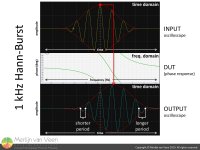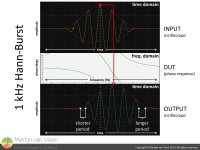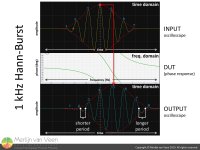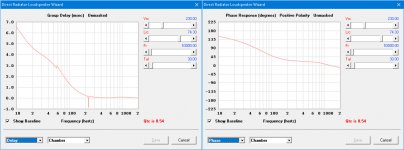so you are saying that a short (gated) sine wave cannot contain a single frequency?
Yes.
No need to call it gated IMO, short is fine, specifically how long is better. Gating can imply something other than the simple start and stop time we need for this topic.
Open up whatever fft tool you have available and analyze different lengths of sine signals. No speaker measurement, no loop back recording, just make sine signals of different lengths and view the resultant fft. It's all there.
Ive gained some more knowledge since your last post....I've concluded that this new output via short tone burst is actually distortion....Im pretty sure I am right.
what I cannot conclude is the idea that I've been right all along....the group delay is the time delay of the amplitude envelope at specific frequencies.....
ok well thats what I just defined group delay as.....unless phase is always kept within an offset ie patternflip....
group delay is a measure of phase delay without the pattern flip.....the pattern flip is for reference so we can predict cancellations....as we push phase further out...it never really flips it just has another chance to realign....this is measured in ms and is group delay....final answer lol
Somehow that is wrong and right...I think the difference is that the whole amplitude envelope gets shifted and the phase shift is coincial
what I cannot conclude is the idea that I've been right all along....the group delay is the time delay of the amplitude envelope at specific frequencies.....
Phase delay is the time delay of the phase experienced by the individual sinusoidal components."
ok well thats what I just defined group delay as.....unless phase is always kept within an offset ie patternflip....
group delay is a measure of phase delay without the pattern flip.....the pattern flip is for reference so we can predict cancellations....as we push phase further out...it never really flips it just has another chance to realign....this is measured in ms and is group delay....final answer lol
Somehow that is wrong and right...I think the difference is that the whole amplitude envelope gets shifted and the phase shift is coincial
Last edited:
I've concluded that this new output via short tone burst is actually distortion
I don't think that is quite correct. I am also not sure if it matters and I also also have not the knowledge to comment further on the matter.
vsMartin King
Admin
Group delay is not measured, group delay is calculated in the frequency domain from the SPL frequency response plot, the time domain is not involved.
https://www.diyaudio.com/forums/attachment.php?attachmentid=943821&stc=1&d=1618782843
this bothers me...I don't enjoy being lied to...I know he knows better because we've had this debate before and the same problem exist...I use some words technically wrong in my explanations...the truth is Martin doesn't believe that group delay can be an audible issue...If thats how you feel just say it...He tries to dress it up as basically another way to express phase....and its more than that.
Attachments
Here you go Camplo, by far the best explanation of group delay that I've found.
Has a lot of material concerning wavelets too, a very interesting project i've got going on right now.
A little verbose for my taste, but essentially correct.
It's how group delay is related to perception that interests me.
Camplo
I would look up some texts in the subject of what is generally called "signals and systems". This material is common to all branches of audio engineering, acoustical, mechanical and electrical. Each has slightly different names and preferences, but its really all the same. You are clearly confused about things, although refreshingly curious. Teaching the fundamentals in a forum is just not effective or practical.
I would look up some texts in the subject of what is generally called "signals and systems". This material is common to all branches of audio engineering, acoustical, mechanical and electrical. Each has slightly different names and preferences, but its really all the same. You are clearly confused about things, although refreshingly curious. Teaching the fundamentals in a forum is just not effective or practical.
A little verbose for my taste, but essentially correct.
probably the most confusing part is how I accurately theorize how it should sound....and look...according the thumbnail above and the video before it....yet....someone how I'm not saying it right? very confusing....I feel like I am reiterating the article....but apparently somehow I am inaccurate....
here he calls the individual frequencies of group delay phase delay (this one sounds shaky but only because phase is measured in radians....I think phase can be converted into ms as well...I guess the measure of phase has to refer to an angle....but group delay shifts phase as well...so I said that group delay is a phase shift without a pattern flip...instead ms increases/decreases without limit ( the phase representation would be the addition of radians past 360 degrees, for example a 720 degree phase shift)....supported by thisThe group of frequencies is decomposed and its component frequencies' phases have been delayed (phase delay).
from Phase Delay vs. Group Delay – Marki Microwave RF & MicrowaveA variable length delay line, therefore, can only change the phase by changing the group delay. But by changing the group delay, you are changing the integral (slope) of the phase vs. frequency."
I've said that the input signal differs from the output...that the electrical signal does what the woofer cannot...it is a distortion....and that group delay is a measure of that latency of much extra time it took to leave the "train station"I call it the train-station-effect where you have cars, containing groups of frequencies, going into the station all at once which come out of the other end of the station in a different order.
I've said that group delay is a measure of the amplitude envelope....excess time taken to get to max amplitude to be exact....Notice the stretching of the imaginary amplitude envelope. Its crest shifting to the right (indicated by the red arrow). The amplitude envelope's center of mass for the one-third-octave-wide group of frequencies has been time delayed.
I've said all of that...in my own words...those quotes are from the article(s) that has been deemed "correct"....where did I mess up???
Last edited:
The way we measure phase it stops at 360( or is it 180?) degrees....if you could measure a 1440 degree phase shift or such you would not need to use ms for group delay...you could use the same units as phase....
The problem is I understood group delay since the get go....not on a technically correct level but I correctly theorized what it would sound like....then I'd go and try to explain myself to people who have a better technical understanding but not an applied understanding (apparently) and I lose the battle because I don't use words correctly nor do I know the math involved....applied vs theoretical.... If your math does not account for the amplitude aspect of group delay...it is flawed...as amplitude is delayed through time it goes in and out of phase....most people I have come across stop there....The truth of the matter is that eventually with high enough group delay, peak amplitude latency is pushed so far out that it becomes audibly detached from the rest of the signal....We have different thresholds to this time based distortion depending on frequency. Nothing has changed in my perspective, from my first theory till now... only a better use of wording...
Anyone wanting to see group delay...look no further....

Imagine the rest of the signal vs any other part of the signal and the latency measured in milliseconds...gives time from input peak amplitude to output peak amplitude....its that simple....Want to hear it? Here it goes...
Audible sustain of Group Delay - YouTube
The only thing I don't understand....outside of the formula to derive GD from frequency vs phase....is in the picture above, the group delayed signal has more crest/troughs than the original signal....that is confusing. I also am not certain where 0ms is in the picture above....its dead cented or where the signal begins to oscillate???? I don't need to know that to build a loudspeaker properly....but it is interesting
Group Delay Demystified*
" This plot makes it obvious that we cannot in general equate time delay and group delay, but this comparison helps to simplify the topic a bit. i.e. Group Delay IS a MEASUREMENT of TIME, and is similar in value to ordinary time delay in the filter's pass band where the phase is most linear."
"In loose terms, Group Delay is the amount of time required for a signal to propagate through a device."
What is Group Delay
In all the examples I've seen....group delay is essentially the amplitude envelope in milliseconds....which is important to distinguish. Lets say an input signal at 0ms vs 40ms group delay in the output...the time to reach amplitude matching the input signal is delayed....hence the title "amplitude envelope". In the first article I cite, they refer to this as propagation which means to build up or increase...
Merlijn van Veen - Group Delay 101
Martin King
I know you have a very great mathematical understanding....according to your quote here "Group Delay is a very poor label, it does NOT indicate ANY kind of TIME delay."
The articles above are not agreeing....can you please explain where they messed up???....in the second article they actually play for us an exaggerated group delay example at 100hz. There are multiple articles on the internet discussing how much group delay is needed for the human ear to detect it at certain frequencies....If they are not hearing a time distortion what exactly are they hearing?
...unlike phase, group delay moves the point in time, of the output signal, where the first crest matches the amplitude of the original signal. This is what is shown in the examples in both articles. Amplitude Envelope.
Anyone wanting to see group delay...look no further....
Imagine the rest of the signal vs any other part of the signal and the latency measured in milliseconds...gives time from input peak amplitude to output peak amplitude....its that simple....Want to hear it? Here it goes...
Audible sustain of Group Delay - YouTube
The only thing I don't understand....outside of the formula to derive GD from frequency vs phase....is in the picture above, the group delayed signal has more crest/troughs than the original signal....that is confusing. I also am not certain where 0ms is in the picture above....its dead cented or where the signal begins to oscillate???? I don't need to know that to build a loudspeaker properly....but it is interesting
Attachments
Last edited:
There is no zero because its location is arbitrary. Of course there is always the big-bang as time=0.
From what I see there are the same number of "crests/troughs" in both signals.
To me group delay is imply the slope of the phase curve, that's its definition. Phase delay is the value of time delay at that frequency and the group delay is its slope. That does not seem to me to be very complex, but it's effects get all kinds of discussion. Many misleading and/or irrelevant.
The audibility of group delay varies from insignificant to a minor effect at best (unless excessive), hence unless you have fixed the other 95% of a loudspeakers problems, group delay should not be on your radar.
From what I see there are the same number of "crests/troughs" in both signals.
To me group delay is imply the slope of the phase curve, that's its definition. Phase delay is the value of time delay at that frequency and the group delay is its slope. That does not seem to me to be very complex, but it's effects get all kinds of discussion. Many misleading and/or irrelevant.
The audibility of group delay varies from insignificant to a minor effect at best (unless excessive), hence unless you have fixed the other 95% of a loudspeakers problems, group delay should not be on your radar.
The audibility of group delay varies from insignificant to a minor effect at best (unless excessive), hence unless you have fixed the other 95% of a loudspeakers problems, group delay should not be on your radar.
I readily acknowledge that opinion on the audibility of group delay is widely accepted as true.
Also strongly agree that until the other 95% of loudspeakers problems are fixed, group delay is a low priority.
But once the 95% are fixed, I think eliminating group delay, aka flat phase, it is the highest priority for reaching a new level of sonic resolution.
Well it depends on how sensitive you are to it....for me it apparently is a big deal...then again...as a drummer, with very good timing...I am sensitive to it....Now that I understand the lingo a little better....I can speak more confidently about it.
Group delay is very important for a person adjusting compression on a bass instrument.. Since group delay issues typically happen down low...high group delay gives the impression of a slow release of a compressor....If the bass is distorted in time, how could one easily adjust the release of compression when it sounds as if it already has compression with a release on it....High group delay in the bass region gives the impressing of looseness....(see the audio example please) so if one were trying to tighten the bass of an electronic instrument via the attack envelope....how could one do so, accurately if the bass sounds as if it has a slow attack already?
I like what this guy said
I think Gedlee is saying that the group delay curve shows phase delay? Please clarify?
The higher the group delay figure the father out in time the "pressure front" sits...I have no idea how to relate that to this sentence
To be 100% transparent....this, for me, is an issue of vented designs where group delay has risen high due to a tuning note being placed in the passband...a vent that likely is understuffed...there are other configurations of vented enclosures as well (tapped horn) where the group delay figures are pushed way out there. Take into consideration that filters way be in play to exaggerate the group delay down low, and no less a culprit worth analyzing. As a general listener this may be ignorable for some...but as a critical listener responsible for designing signal, in particular in the bass region, this may make or break your ability to judge accurately, your decisions with compression and the attack envelope on electronic instruments. the easiest way to reference this in your system today is to listen to a song with an 808 in it, in headphones vs you're loudspeaker system....if the difference shows the bass being a little later to the party with the loudspeakers...you are hearing group delay...not everyone is as sensitive as others to this affect.
Group delay is very important for a person adjusting compression on a bass instrument.. Since group delay issues typically happen down low...high group delay gives the impression of a slow release of a compressor....If the bass is distorted in time, how could one easily adjust the release of compression when it sounds as if it already has compression with a release on it....High group delay in the bass region gives the impressing of looseness....(see the audio example please) so if one were trying to tighten the bass of an electronic instrument via the attack envelope....how could one do so, accurately if the bass sounds as if it has a slow attack already?
I like what this guy said
And it's something that we all have to live with.
Phase, My pet peeve. Is the place of a pressure front ( all sound is a pressure difference to the surrounding atmosphere right?....
I think Gedlee is saying that the group delay curve shows phase delay? Please clarify?
The higher the group delay figure the father out in time the "pressure front" sits...I have no idea how to relate that to this sentence
I think you are saying that when ever the signal is sent....that equals 0ms?There is no zero because its location is arbitrary. Of course there is always the big-bang as time=0.
To be 100% transparent....this, for me, is an issue of vented designs where group delay has risen high due to a tuning note being placed in the passband...a vent that likely is understuffed...there are other configurations of vented enclosures as well (tapped horn) where the group delay figures are pushed way out there. Take into consideration that filters way be in play to exaggerate the group delay down low, and no less a culprit worth analyzing. As a general listener this may be ignorable for some...but as a critical listener responsible for designing signal, in particular in the bass region, this may make or break your ability to judge accurately, your decisions with compression and the attack envelope on electronic instruments. the easiest way to reference this in your system today is to listen to a song with an 808 in it, in headphones vs you're loudspeaker system....if the difference shows the bass being a little later to the party with the loudspeakers...you are hearing group delay...not everyone is as sensitive as others to this affect.
Last edited:
But once the 95% are fixed, I think eliminating group delay, aka flat phase, it is the highest priority for reaching a new level of sonic resolution.
Once everything else has been fixed, what remains is always the highest priority. While I might agree that group delay is the next priority, there is only scant evidence of this.
I think Gedlee is saying that the group delay curve shows phase delay? Please clarify?
No, the group delay at some frequency is the slope of the phase line at that frequency. Phase delay is the delay at that frequency corresponding to the phase value. One is the delay at a specific point - a specific frequency - and the other is the delay that a group of frequencies about that point will be delayed.
When talking phase defining zero is critical, as you imply, but group delay does not depend on this definition in any way.
That is wrong. You are reading the time delay of a signal through a system of a group of frequencies about that point, which is not necessarily the same as the phase delay of a pure tone at that frequency. Your ear cannot detect phase delay but it can detect group delay.
Sorry I was trying to rewrite the question before you answered...Though I am still glad you answered...
To anyone reading, the response above is too this question
This is about the clearest explanation from a trusted source as I've ever gotten, lord have mercy....
Phase delay is on offset of phase yet the phase entry remains in the same place in time....Group delay is the time delay experienced when a group of frequencies are passed through a system....how big the group has to be...no idea.
To anyone reading, the response above is too this question
can I read the phase delay on the group delay chart
That is wrong. You are reading the time delay of a signal through a system of a group of frequencies about that point, which is not necessarily the same as the phase delay of a pure tone at that frequency. Your ear cannot detect phase delay but it can detect group delay.
This is about the clearest explanation from a trusted source as I've ever gotten, lord have mercy....
why is there such a focus on "group" does the system respond differently when just a single signal is played? Thus, the time delay one might have within group delay...is not present if the input is a single frequency....right? Holy sht I think I got itthe time delay of a signal through a system of a group of frequencies about that point
Phase delay is on offset of phase yet the phase entry remains in the same place in time....Group delay is the time delay experienced when a group of frequencies are passed through a system....how big the group has to be...no idea.
Last edited:
Why the Name "Group Delay"
We all understand ordinary time delay (phase shift), but what is group delay. Consider a simple example of a square wave, which as you know, is composed of a large group of frequency components. A square wave is square only because its frequency components are in proper phase alignment with one another. If we pass a square wave through a device and expect it to remain square, then we need to ensure that the device doesn't misalign these frequency components. A Group Delay measurement shows us how much a device causes these frequency components to become misaligned
I guess this is the tell...
Last edited:
- Home
- Loudspeakers
- Multi-Way
- Is it possible to cover the whole spectrum, high SPL, low distortion with a 2-way?



